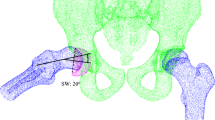Abstract
Background
The exact pathomechanism of slipped upper femoral epiphysis (SUFE) remains elusive. This paper suggests a generalised abnormality of the development or maturation of cartilage as a possible cause.
Objective
It is proposed that SUFE is part of a generalised abnormality of the cartilage formation or maturation resulting in abnormal measurements of cartilaginous joint structures.
Materials and methods
Radiographs of SUFE patients were assessed for the width of the unaffected hip joint and the symphysis pubis. Comparison with previously published normal values was made.
Results
Fifty-one patients were assessed, 35 male, 16 female. The average age was 12 years and 11 months combined for both sexes, 13 years 8 months for boys, 11 years 4 months for girls. Width of the symphysis pubis was assessed on 46 datasets, and comparison with normal values was performed using the Wilcoxon paired rank test. Statistical significance was set as p < 0.05. The average expected width was 5.8 mm (5.4–6.2 mm), the average measured width was 7.3 mm (3.5–12 mm), median value 7.0 mm, and the difference is statistically significant. Cartilage thickness of the uninvolved hip joint could be assessed in 46 cases, and comparison using the Wilcoxon paired rank test resulted in a statistically significant difference (significance set as p < 0.05). The average expected width was 4.9 mm (3.6–6.5 mm), the average measured width was 5.5 mm (4–8 mm), and median 5.3 mm.
Conclusions
The results indicate that SUFE patients display a generalised increased width of joint cartilage for their age. This could be due to increased cartilage formation or decreased maturation or a combination of the two, and could explain the increased mechanical vulnerability of these children to normal or abnormal stresses, despite histologically normal organisation of the physis as shown in previous studies.


Similar content being viewed by others
References
Loder RT. The demographics of slipped capital femoral epiphysis. An international multicenter study. Clin Orthop. 1996; 322:8–27.
Kelsey JL, Keggi KJ, Southwick WO. The incidence and distribution of slipped capital femoral epiphysis in Connecticut and Southwestern United States. J Bone Joint Surg Am. 1970;52:1203–16.
Brown D. Seasonal variation of slipped capital femoral epiphysis in the United States. J Pediatr Orthop. 2004;24:139–43.
Harland U, Krappel FA. Value of ultrasound, CT, and MRI in the diagnosis of slipped capital femoral epiphysis (SCFE). Orthopade. 2002;31:851–6.
Poussa M, Schlenzka D, Yrjonen T. Body mass index and slipped capital femoral epiphysis. J Pediatr Orthop B. 2003;12:369–71.
Milz S, Boszczyk A, Putz R. Development and functional structure of the epiphyseal plate. Orthopade. 2002;31:835–40.
Oppenheim WL, Bowen RE, McDonough PW, Funahashi TT, Salusky IB. Outcome of slipped capital femoral epiphysis in renal osteodystrophy. J Pediatr Orthop. 2003;23:169–74.
Schultz WR, Weinstein JN, Weinstein SL, Smith BG. Prophylactic pinning of the contralateral hip in slipped capital femoral epiphysis: evaluation of long-term outcome for the contralateral hip with use of decision analysis. J Bone Joint Surg Am. 2002;84-A:1305–14.
Weiner D. Pathogenesis of slipped capital femoral epiphysis: current concepts. J Pediatr Orthop B. 1996;5:67–73.
Loder RT, Aronson DD, Greenfield ML. The epidemiology of bilateral slipped capital femoral epiphysis. A study of children in Michigan. J Bone Joint Surg Am. 1993;75:1141–7.
Engelhardt P. Slipped capital femoral epiphysis and the “healthy” opposite hip. Orthopade. 2002;31:888–93.
Patel K, Chapman S. Normal symphysis pubis width in children. Clin Radiol. 1993;47:56–7.
Aronson DD, Carlson WE. Slipped capital femoral epiphysis. A prospective study of fixation with a single screw. J Bone Joint Surg Am. 1992;74:810–9.
Hughes LO, Aronson J, Smith HS. Normal radiographic values for cartilage thickness and physeal angle in the pediatric hip. J Pediatr Orthop. 1999;19:443–8.
Lehmann CL, Arons RR, Loder RT, Vitale MG. The epidemiology of slipped capital femoral epiphysis: an update. J Pediatr Orthop. 2006;26:286–90.
Fishkin Z, Armstrong DG, Shah H, Patra A, Mihalko WM. Proximal femoral physis shear in slipped capital femoral epiphysis—a finite element study. J Pediatr Orthop. 2006;26:291–4.
Guermazi A, Miaux Y, Zaim S, Peterfy CG, White D, Genant HK. Metallic artefacts in MR imaging: effects of main field orientation and strength. Clin Radiol. 2003;58:322–8.
Conrozier T, Lequesne MG, Tron AM, Mathieu P, Berdah L, Vignon E. The effects of position on the radiographic joint space in osteoarthritis of the hip. Osteoarthritis Cartilage. 1997;5:17–22.
Pessis E, Chevrot A, Drape JL, et al. Study of the joint space of the hip on supine and weight-bearing digital radiographs. Clin Radiol. 1999;54:528–32.
Author information
Authors and Affiliations
Corresponding author
Rights and permissions
About this article
Cite this article
Tins, B., Cassar-Pullicino, V. & Haddaway, M. Symphysis pubis width and unaffected hip joint width in patients with slipped upper femoral epiphysis: widening compared with normal values. Skeletal Radiol 39, 353–357 (2010). https://doi.org/10.1007/s00256-009-0777-8
Received:
Accepted:
Published:
Issue Date:
DOI: https://doi.org/10.1007/s00256-009-0777-8




